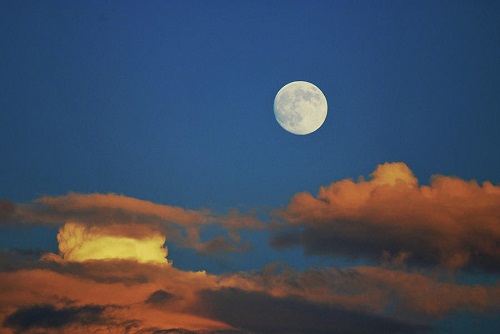FWP:
For background see S. R. Faruqi's choices. This verse is NOT one of his choices; I thought it was interesting and have added it myself. For more on Ghalib's unpublished verses, see the discussion in {4,8x}.
Gyan Chand here comes through most creditably. He makes exactly the key point: that the duzd-e ;hinaa has been used both idiomatically (the moon looks like-- or actually is?-- a pallid, uncolored spot on beloved's otherwise henna-ed hand), and literally (the moon at sunset steals its reddish tint from the beloved's henna-ed hand). Another 'henna-thief' verse: {436x,1}.
This verse, with its elegant duality of meaning (either the moon is undesirably white, or else it is culpably red), belongs to the set of verse that make snide remarks about the natural world; for others, see {4,8x}. But the natural world also cooperates with the lover, for the sunset itself becomes a 'figurative', or 'ornate', or 'colorful' (see the definition of rangii;N above) witness to the lover's claim. That final superb bit of wordplay is like icing on the cake. In my view, this verse fully deserves to be in the divan.


Asi:
Having seen the sunset-stained moon, the lover claims that the moon has stolen henna from the adorned palm of his beloved, and a 'colorful' witness is the sunset, which is telling of this state of affairs.
A second [meaning] is that the moon is a 'henna-thief', and that is a thief who has remained in my beloved's adorned palm. A 'henna-thief' is what they call the whiteness that remains on the hand when henna is applied, or that is [deliberately] left because of jewelry and ornaments. Calling this empty place, or this shape, the 'moon', he has made the sunset a witness to his claim. With regard to the 'henna-thief', the sunset's being a witness is extremely harmonious and fitting. This second meaning seems to be more fitting.
== Asi, p. 297